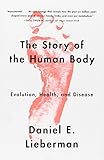Found in 2 comments on Hacker News
VeejayRampay · 2015-01-15
· Original
thread
The disconnect between what our bodies are built for and the lives we're living in 2015 is the source of many modern diseases. Daniel Lieberman [1] has an excellent book on the matter called The Story of the Human Body: Evolution, Health and Disease [2]. Reading it was a deep realization for me that I needed to change my way of life and forced me to eat better (more fruits, vegetables, slashing everything processed from my diet) and exercise more.
[1] http://en.wikipedia.org/wiki/Daniel_Lieberman [2] http://www.amazon.com/The-Story-Human-Body-Evolution/dp/0307...


See "Against the Grain", by James C. Scott (https://www.amazon.com/Against-Grain-History-Earliest-States...), and also "The Story of the Human Body", by Daniel E. Lieberman (https://www.amazon.com/Story-Human-Body-Evolution-Disease/dp...).
I'm seeing guidance to, over next weeks and months, increase ventilation, open windows, and socialize outdoors instead of inside. Fortunately, it's spring here in the Northern Hemisphere.
Long term, the WFH trend may only increase. Maybe light industrial work could disperse as well?
I was struck by NY Times list of the workers who face the greatest coronavirus risks (https://www.nytimes.com/interactive/2020/03/15/business/econ...).
Least risk? Loggers.